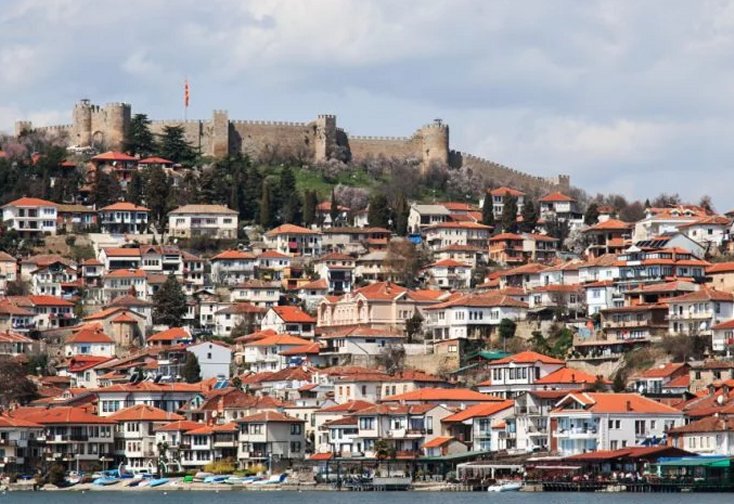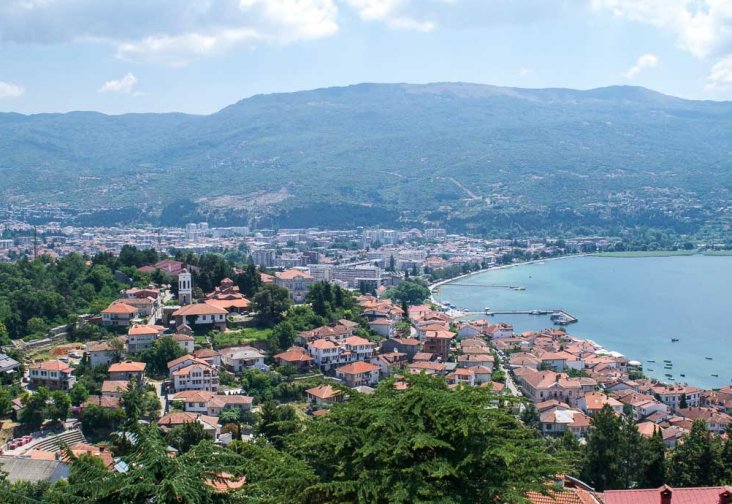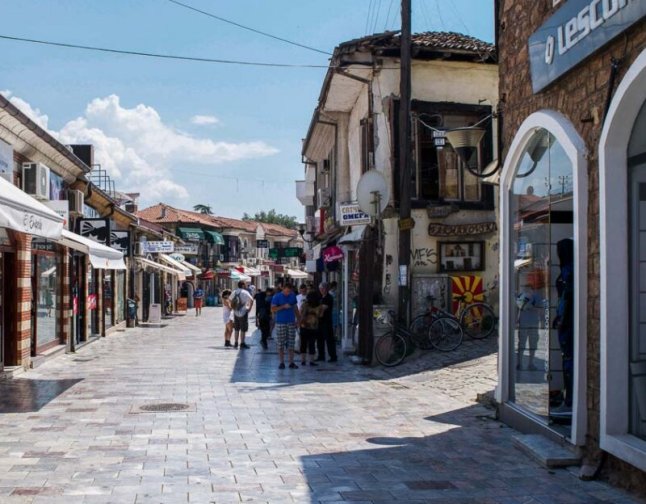OHRID . . .
Ohrid is the seat of the Ohrid Municipality. It is the largest city on Lake Ohrid and the eighth-largest city in the country, with the municipality recording a population of over 42,000 inhabitants as of 2002. Ohrid is known for once having 365 churches, one for each day of the year, and has been referred to as a "Jerusalem of the Balkans". The city is rich in picturesque houses and monuments, and tourism is predominant. It is located southwest of Skopje, west of Resen and Bitola. In 1979 and in 1980 respectively, Ohrid and Lake Ohrid were accepted as Cultural and Natural World Heritage Sites by UNESCO. Ohrid is one of only 28 sites that are part of UNESCO's World Heritage that are Cultural as well as Natural sites.
 |
 |
In antiquity the city was known under the ancient Greek name of Λυχνίς (Lychnis) and Λυχνιδός (Lychnidos) and the Latin Lychnidus, probably meaning "city of light", literally "a precious stone that emits light", from λύχνος (lychnos), "lamp, portable light". Polybius, writing in the second century BC, refers to the town as Λυχνίδιον - Lichnidion. It became capital of the First Bulgarian Empire in the early medieval period, and was often referred to by Byzantine writers as Achrida (Ἄχριδα, Ὄχριδα, or Ἄχρις) By 879 AD, the town was no longer called Lychnidos but was referred to as Ohrid. It has been proposed by Katičić that the modern name is a modified version of the ancient Greek name, where the transition of "Lychnidus" to "Ohrid" presupposes a characteristic sound development from Albanian which may have thereby entered Slavic. According to Doikov, Ohrid may have originated from the Slavic expression "во рид" (vo rid) meaning "on hill". In Macedonian and the other South Slavic languages, the name of the city is Ohrid (Охрид). In Albanian, the city is known as Ohër or Ohri and in modern Greek Ochrida (Οχρίδα, Ωχρίδα) and Achrida (Αχρίδα). The name of the city in Aromanian is Uhrida or Ohãrda.
 |
 |
History
Antiquity: The earliest inhabitants of the widest Lake Ohrid region were the Illyrian tribes of Enchele and Dassaretii. According to a tradition the town, called Lychnidos (Ancient Greek: Λυχνιδός) in classical antiquity, was founded by the Phoenician king of Thebes, Cadmus who, banished from Thebes, in Boeotia, fled to the Enchele to the north and founded Lychnidus on the shore of Lake Ohrid and Budva in Montenegro. Lychnidos was the capital city of the Illyrian Dassaretii.
According to recent excavations this was a town as early as of the era of king Philip II of Macedon. They conclude that Samuil's Fortress was built on the place of an earlier fortification, dated to 4th century BC. In 210 BCE, Philip V of Macedon raided a number of southern Illyrian communities. He maintained a garrison at Lychnidus but lost control of the settlement in 208 BCE, when its commander joined local leader Aeropus and invited the Dardani in the region. During the Roman conquests, towards the end of 3rd and the beginning of 2nd century BC, Lychnidus is mentioned as a town near or within Dassaretia. In Roman times it was located along the Via Egnatia, which connected the Adriatic port Dyrrachion (present-day Durrës) with Byzantium. Archaeological excavations (e.g., the Polyconch Basilica from 5th century) prove early adoption of Christianity in the area. Bishops from Lychnidos participated in multiple ecumenical councils.
Middle Ages: The South Slavs began to arrive in the area during the 6th century AD. By the early 7th century it was colonized by a Slavic tribe known as the Berziti. Bulgaria conquered the city around 840. The name Ohrid first appeared in 879. The Ohrid Literary School established in 886 by Clement of Ohrid became one of the two major cultural centres of the First Bulgarian Empire. Between 990 and 1015, Ohrid was the capital and stronghold of the Bulgarian Empire. From 990 to 1018 Ohrid was also the seat of the Bulgarian Patriarchate. After the Byzantine reconquest of the city in 1018 by Basil II, the Bulgarian Patriarchate was downgraded to an Archbishopric of Ohrid, and placed under the authority of the Ecumenical Patriarch of Constantinople.
The higher clergy after 1018 was almost invariably Greek, including during the period of Ottoman domination, until the abolition of the archbishopric in 1767. At the beginning of the 16th century the archbishopric reached its peak subordinating the Sofia, Vidin, Vlach and Moldavian eparchies, part of the former medieval Serbian Patriarchate of Peć, (including Patriarchal Monastery of Peć itself), and even the Orthodox districts of Italy (Apulia, Calabria and Sicily), Venice and Dalmatia.
As an episcopal city, Ohrid was a cultural center of great importance for the Balkans. Almost all surviving churches were built by the Byzantines and by the Bulgarians, the rest of them date back to the short time of Serbian rule during the late Middle Ages. Bohemond, leading a Norman army from southern Italy, took the city in 1083. Byzantines regained it in 1085. In the 13th and 14th century the city changed hands between the Despotate of Epirus, the Bulgarian, the Byzantine and the Serbian Empire, as well as Albanian rulers. In the mid-13th century Ohrid was one of the cities ruled by Pal Gropa, a member of the Albanian noble Gropa family. In a text by Emperor John VI Kantakouzenos there is mention of nomadic Albanians present in the vicinity of Ohrid at around 1328. In 1334 the city was captured by Stefan Uroš IV Dušan and incorporated in the Serbian Empire. After Dusan's death the city came under the control of Andrea Gropa, while after his death Prince Marko incorporated it in the Kingdom of Prilep. In the early 1370s Marko lost Ohrid to Pal II Gropa, another member of the Gropa family and unsuccessfully tried to recapture it in 1375 with Ottoman assistance.
In 1395 the Ottomans under Bayezid I captured the city which became the seat of the newly established Sanjak of Ohrid. Some time after Skanderbeg had liberated Krujë to begin his rebellion, his troops - in coordination with Gjergj Arianiti and Zahari Gropa (of the local Albanian Gropa noble family) - liberated Ohrid and the castle of Svetigrad. In 14–15 September 1464, 12,000 Albanian troops of the League of Lezhë and 1,000 of the Republic of Venice defeated a 14,000-man Ottoman force near the city in the Battle of Ohrid which ended in an Albanian victory over the Ottomans. When Mehmed II returned from Albania after his actions against Gjergj Kastrioti Skanderbeg in 1466 he dethroned Dorotheos, the Archbishop of Ohrid, and expatriated him together with his clerks and boyars and considerable number of citizens of Ohrid to Istanbul, probably because of their anti-Ottoman activities during Skanderbeg's rebellion when many citizens of Ohrid, including Dorotheos and his clergy, supported Skanderbeg and his fight.
Ottoman Period: During the 16th century, Ohrid was located in the Sanjak of Ohrid. The Sanjak of Ohrid, in the years 1529-1536, had 33,271 households (32,648 Christians and 623 Muslims), with 1331 widows and 3392 unmarried singles. There were 859 settlements and 10 cities, with an average of 28.7 houses per settlement. Ohrid itself had 337 Christian families, 44 unmarried singles, 12 widows and 93 Muslim families. In 1583, the Sanjak of Ohrid was made up of several Kazas, including the Kaza of Ohrid, which were in turn made of Nahiyes; the Ottoman Defter recorded, within the Nahiya of Ohrid, 2,920 Christian homes, 627 unmarried singles and 465 Muslim families within a total of 107 settlements. The Christian population declined during the first centuries of Ottoman rule. In 1664 there were only 142 Christian houses. The situation changed in the 18th century when Ohrid emerged as an important trade center on a major trade route. At the end of this century it had around five thousand inhabitants. Towards the end of the 18th century and in the early part of the 19th century, Ohrid region, like other parts of European Turkey, was a hotbed of unrest. In the 19th century the region of Ohrid became part of the Pashalik of Scutari, ruled by the Bushati family. After the Christian population of the bishopric of Ohrid voted on a plebiscite in 1874 overwhelmingly in favour of joining the Bulgarian Exarchate (97%), the Exarchate became in control of the area.
Modern: Before 1912, Ohrid was a township center bounded to Monastir sanjak in Manastir Vilayet (present-day Bitola). The city remained under Ottoman rule until 29 November 1912, when the Serbian army took control of the city during the Balkan Wars and later made it the capital of Ohrid district. In Ohrid, Serbian forces killed 150 Bulgarians and 500 people consisting of Albanians and Turks. In September 1913 local Albanian and pro-Bulgarian Internal Macedonian Revolutionary Organization leaders rebelled against the Kingdom of Serbia. It was occupied by Kingdom of Bulgaria between 1915 and 1918 during World War I.
During Kingdom of Yugoslavia Ohrid continued to be as an independent district (Охридског округа) (1918-1922), then it became a part of Bitola Oblast (1920-1929), and then from 1929 to 1941, Ohrid was part of the Vardar Banovina. It was occupied again by Bulgaria between 1941 and 1944 during World War II. Since the days of SFR Yugoslavia Ohrid has been the municipal seat of Municipality of Ohrid (Општина Охрид). Since 1991 the town was part of the Republic of North Macedonia.
Main sights
There is a legend supported by observations by the 17th century Ottoman traveler Evliya Çelebi that there were 365 chapels within the town boundaries, one for every day of the year. Today this number is significantly smaller.
Church of St. Sophia
Church of Saints Clement and Panteleimon
Church of St. John at Kaneo
Church of St. George
Church of St. Zaum
Icon Gallery-Ohrid
Monastery of Saint Naum
Church of St. Petka
Church of St. Stefan
Vestiges of basilicas from the early-Christian time, e.g. Basilica of St. Erazmo (4th century)
Robevi family house, museum of archeology
Ancient Theatre of Ohrid
Church of St. Vrači, with frescos from the 14th century. A 14th-century icon from the church is depicted on the obverse of the 1000 denars banknote, issued in 1996 and 2003.
Besides being a holy center of the region, it is also the source of knowledge and pan-Slavic literacy. The restored Monastery at Plaošnik was actually one of the oldest Universities in the western world, dating before the 10th century.
Ohrid is also home to Vila Biljana, which serves as an official residence of the President of North Macedonia.